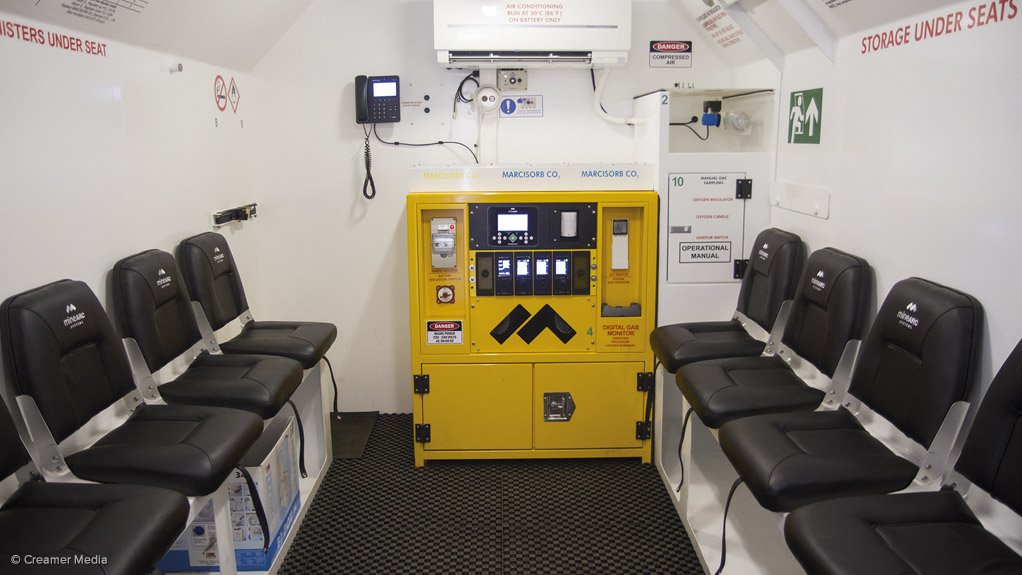A Zambian copper mine is set to receive delivery of 12 MineSAFE underground refuge chambers from manufacturer and supplier MineARC, incorporating its new System Intelligence package, including the GuardIAN remote monitoring system, a compressed air management system and Aura-FX digital gas monitoring system, at the end of the first quarter this year.
MineARC business development manager Jason van Niekerk explains that GuardIAN is an independent system, launched mid-2016, which continuously monitors all vital refuge operating systems. GuardIAN enables real-time monitoring, ensuring that an operation’s fleet of refuge chambers are always emergency ready. During standby mode, GuardIAN checks for component faults and monitors refuge chamber activity.
MineARC hired a dedicated software engineer to develop the GuardIAN system, with Van Niekerk noting that the company can update and modify refuge chambers that have had MineARC’s refuge chambers installed prior to GuardIAN’s launch.
The GuardIAN secure online interface is hosted on an internal server within the refuge chamber, so that no client software installation is required. A responsive webpage is easily accessible from any computer, tablet or smartphone, and features a summary of the entire refuge chamber fleet and overall operational status, with the ability to provide a detailed report on each chamber.
Other major features include an internal motion-activated Internet protocol (IP) camera to assist in evacuation planning; real-time, recorded video streaming; a voice-over IP video phone for face-to-face communication between the refuge chamber and the surface; a link to the MineARC digital controller; streaming system data; the submission of event logging and fault diagnostics to the surface control room(s); and email alerts and notifications sent to designated personnel.
The full System Intelligence package can reduce operational expenses by lowering energy costs by improving mine-air use, providing flood protection, eliminating costly chamber refurbishment, decreasing replacement parts because of theft, reducing service kit costs and providing advanced maintenance planning.
MineARC refuge chambers are constructed using sturdy 5 mm plate metal coated in highly durable long-lasting anticorrosion paint. MineARC’s MineSAFE range of refuge chambers can hold up to 30 people in the standard configurations. However, all their designs can be customised to hold as many personnel as required based on site specifications.
An additional feature, recently incorporated into the chamber, is MineARC’s new Aura-FX digital gas monitoring system. It is a proprietary fixed gas monitoring unit designed specifically for use in MineARC refuge chambers.
The Aura-FX can individually monitor up to 11 gases through a series of user-friendly, digital screens. Audible voice alarms will prompt occupants to replace scrubbing chemicals or adjust oxygen supply levels in the refuge chamber as required.
When used as part of the MineARC System Intelligence network, Aura-FX provides real-time gas monitoring data and analysis through the GuardIAN dashboard.
Van Niekerk explains that, for the Zambian project, workers needed a system that was more comprehensive and would enable them to monitor temperatures, faults and the number of people inside a chamber. The mine also required a two-way system to communicate with those inside each refuge chamber in an emergency.
This would, for example, enable mine operators to use a medic to guide the people in the chamber from the control room through procedures such as cardiopulmonary resuscitation in the case of an injured worker.
In case of an emergency, the units supplied by the company to operations in Africa enable people to stay in the chamber for up to 36 hours, which is the Australian standard. Van Niekerk highlights that there are other regulations, for example in the US, that have a standard of 48 hours. However, this can be extended to 48 hours, 72 hours or 96 hours, depending on a mine’s requirements.
Further, MineARC GM for Africa Mike Lincoln explains that the company provides preventive maintenance, as the refuge chambers do not include too many wearing parts, with some mines buying service kits to perform maintenance themselves after completing training courses presented by MineARC.
MineARC’s aim for 2017 is to improve the knowledge of safety on mines throughout Africa and improve health and safety regulations across the continent, which are lacking, compared with international standards.
“African regulations in general tend to be out of date and very ‘light’ with regard to the use of underground refuge for emergencies, with no redundancy systems should primary life support fail, or understanding of what is required to sustain life; where they do exist, they are often poorly enforced by the regulatory bodies responsible for them,” concludes Lincoln.
Edited by: Tracy Hancock
Creamer Media Contributing Editor
EMAIL THIS ARTICLE SAVE THIS ARTICLE
ARTICLE ENQUIRY
To subscribe email subscriptions@creamermedia.co.za or click here
To advertise email advertising@creamermedia.co.za or click here













